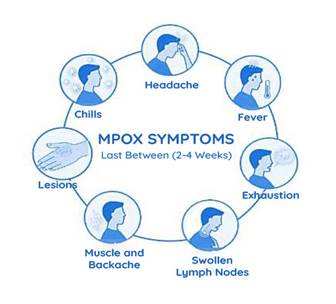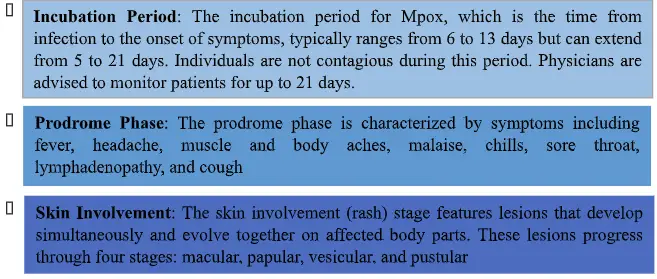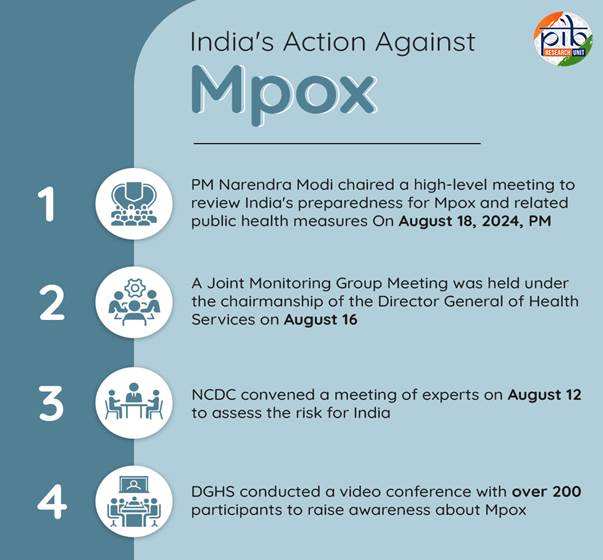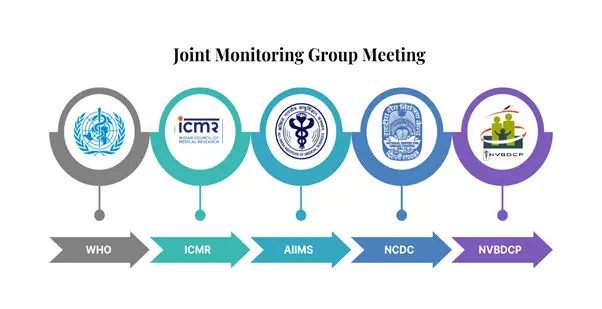
India against Mpox
In mid-August 2024, the World Health Organization (WHO) declared the recent surge of Mpox (formerly known as Monkeypox) cases in parts of Africa as a Public Health Emergency of International Concern (PHEIC). This declaration highlights the severity of the outbreak and calls for coordinated global action. So far, 121 countries have reported over 1,03,048 cases and 229 deaths globally from January 2022 to July 2024. In Africa, 15 countries have confirmed 3,900 cases by September 1, 2024, with the highest numbers reported in the Democratic Republic of the Congo, Burundi, and Nigeria.
In India, 30 Mpox cases have been reported since the WHO’s PHEIC declaration in 2022. Though the situation in India has not escalated to a national emergency, the government has implemented public health strategies and preventive measures to control the spread of the virus.
What is Mpox? Signs, Symptoms, and Prevention
Mpox is a zoonotic viral disease caused by the monkeypox virus, closely related to the smallpox virus. It is characterized by symptoms similar to those of smallpox but is generally less severe. The infection typically lasts between 2-4 weeks, and most individuals recover with proper care. Severe cases, however, are more common among children and individuals with weakened immune systems.
Key signs of Mpox and symptoms:
- Fever
- Headache
- Muscle aches
- Back pain
- Swollen lymph nodes
- Chills
- Exhaustion
- Rash: Begins on the face and spreads to other parts of the body, developing into lesions.

Transmission of Mpox:
Mpox spreads through prolonged close contact with an infected person or direct contact with contaminated materials (clothing, bedding, etc.). The disease can also spread through respiratory droplets, especially during extended face-to-face interactions.
Prevention measures of Mpox:
To prevent the spread of Mpox, the following guidelines should be followed:
- Avoid Contact with materials like bedding or clothing used by an infected person.
- Isolate Infected Individuals from others to limit exposure.
- Maintain Good Hygiene: Wash hands regularly with soap and water, or use alcohol-based hand sanitizers.
- Use Personal Protective Equipment (PPE): When caring for infected patients, wear appropriate protective gear such as masks and gloves.
- Disposal of Contaminated Waste: Follow proper biomedical waste management guidelines when disposing of materials like dressings or other contaminated items.
India’s preventive public health measures against Mpox
The Indian government has been proactive in addressing potential Mpox outbreaks by implementing a series of preventive measures. The key steps taken by the health authorities since mid-2024 include:
1. High-Level government review:
On August 18, 2024, Prime Minister Narendra Modi chaired a high-level meeting to review India’s preparedness for Mpox and associated public health actions. The meeting focused on ensuring that adequate strategies were in place to manage potential cases and control the spread of the disease. It was emphasized that while Mpox is typically self-limiting, lasting between 2 to 4 weeks, enhanced monitoring and preparedness are essential.

2. Expert consultation and strategic planning:
The National Centre for Disease Control (NCDC) held a meeting on August 12, 2024, bringing together national health experts to evaluate Mpox’s risk to India. Several crucial steps were initiated:
- The NCDC updated its earlier Communicable Disease (CD) Alert to include recent developments on Mpox.
- Health teams at international airports and ports were given special training and instructions to handle potential Mpox cases effectively.
3. Strengthening surveillance and awareness:
On August 16, 2024, the Director General of Health Services (DGHS) led a video conference with over 200 participants, including state-level health authorities and the Integrated Disease Surveillance Programme (IDSP) units. The focus was on raising awareness, enhancing disease surveillance, and promoting early case detection.
This was followed by a Joint Monitoring Group Meeting under the chairmanship of the DGHS, bringing together various health experts from agencies such as the NCDC, World Health Organization (WHO), Indian Council of Medical Research (ICMR), and representatives from AIIMS and central government hospitals.

4. Laboratory upgradation:
To ensure that Mpox cases are diagnosed at the earliest, the network of testing laboratories across India has been upgraded. Currently, 35 laboratories are equipped to handle Mpox testing, ensuring nationwide access to accurate and timely diagnosis. This network helps health authorities contain potential outbreaks by isolating infected individuals early.
5. Awareness campaigns for healthcare providers:
Recognizing the importance of timely medical intervention, the Indian government has launched an extensive awareness campaign targeting healthcare professionals across the country. The campaign focuses on educating doctors, nurses, and medical staff on:
- The signs and symptoms of Mpox.
- Timely reporting of suspected cases to surveillance systems.
- Correct isolation and treatment procedures.
These steps are designed to ensure that healthcare providers can quickly identify and manage cases, preventing further transmission.
6. Public health communication:
The government has also directed that protocols for Mpox prevention and treatment be widely disseminated to the public. Effective public health communication is crucial for spreading awareness among citizens about how to prevent the virus and what actions to take if someone suspects infection.
Conclusion
India’s response to Mpox reflects a well-coordinated public health approach, combining proactive measures, expert consultations, enhanced surveillance, and the upgrading of laboratory facilities. With 30 cases reported so far, Indian health authorities have assessed a low risk of a large-scale outbreak. Nevertheless, the government continues to monitor the situation closely and remains prepared to implement additional measures if needed.
By enhancing preparedness and maintaining vigilance, India aims to control any potential spread of Mpox within its borders and protect the health of its citizens.
India against Mpox: सरकार द्वारा रोकथाम के लिए सार्वजनिक स्वास्थ्य उपाय
परिचय
अगस्त 2024 के मध्य में, विश्व स्वास्थ्य संगठन (WHO) ने अफ्रीका के कुछ हिस्सों में Mpox (पहले मंकीपॉक्स) के मामलों में अचानक वृद्धि को अंतर्राष्ट्रीय चिंता की सार्वजनिक स्वास्थ्य आपातकाल (PHEIC) घोषित किया। इस घोषणा ने इस प्रकोप की गंभीरता को उजागर किया और वैश्विक स्तर पर सहयोग की आवश्यकता पर बल दिया। जनवरी 2022 से जुलाई 2024 तक, 121 देशों ने कुल 1,03,048 Mpox मामले और 229 मौतों की सूचना दी। अफ्रीका के 15 देशों में 3,900 मामले दर्ज किए गए हैं, जिसमें सबसे अधिक मामले डेमोक्रेटिक रिपब्लिक ऑफ कांगो, बुरुंडी, और नाइजीरिया से सामने आए हैं।
भारत में, WHO की 2022 में की गई PHEIC घोषणा के बाद से 30 Mpox मामले सामने आए हैं। भले ही भारत में स्थिति इतनी गंभीर नहीं है, फिर भी सरकार ने संभावित प्रकोप को रोकने के लिए सार्वजनिक स्वास्थ्य रणनीतियाँ और रोकथाम उपाय लागू किए हैं।
Mpox क्या है? लक्षण, संकेत और रोकथाम
Mpox एक जूनोटिक वायरस रोग है, जो मंकीपॉक्स वायरस के कारण होता है। इसके लक्षण चेचक (स्मॉलपॉक्स) जैसे होते हैं, लेकिन यह अपेक्षाकृत कम गंभीर होता है। संक्रमण आमतौर पर 2 से 4 सप्ताह तक रहता है, और अधिकांश लोग उचित देखभाल से ठीक हो जाते हैं। हालांकि, बच्चों और कमजोर प्रतिरक्षा प्रणाली वाले लोगों में गंभीर मामले अधिक आम होते हैं।
Mpox के मुख्य लक्षण और संकेत:
- बुखार
- सिरदर्द
- मांसपेशियों में दर्द
- पीठ में दर्द
- सूजी हुई लिम्फ नोड्स
- ठंड लगना
- थकान
- चमड़ी पर चकत्ते: चकत्ते चेहरे पर शुरू होते हैं और शरीर के अन्य हिस्सों में फैलते हैं, बाद में दाने बन जाते हैं।
प्रसार:
Mpox संक्रमित व्यक्ति के साथ लंबे समय तक निकट संपर्क या उनके द्वारा उपयोग किए गए दूषित वस्त्रों (कपड़े, बिस्तर आदि) के संपर्क से फैलता है। इसके अलावा, श्वसन की बूंदों के माध्यम से यह तब फैल सकता है जब लंबे समय तक आमने-सामने संपर्क होता है।
Mpox के रोकथाम के उपाय:
Mpox के प्रसार को रोकने के लिए निम्नलिखित उपाय अपनाने चाहिए:
- संपर्क से बचें: उन वस्त्रों या बिस्तरों से बचें जो संक्रमित व्यक्ति द्वारा उपयोग किए गए हैं।
- संक्रमित व्यक्तियों को अलग रखें: वायरस के प्रसार को सीमित करने के लिए उन्हें दूसरों से अलग रखें।
- साफ-सफाई बनाए रखें: नियमित रूप से साबुन और पानी से हाथ धोएं, या अल्कोहल-आधारित सैनिटाइज़र का उपयोग करें।
- व्यक्तिगत सुरक्षा उपकरण (PPE) का उपयोग करें: संक्रमित रोगियों की देखभाल करते समय मास्क और दस्ताने जैसे उपकरण पहनें।
- दूषित कचरे का सही निपटान करें: संक्रमित कचरे का निपटान बायोमेडिकल वेस्ट मैनेजमेंट दिशानिर्देशों के अनुसार करें।
Mpox के खिलाफ भारत के रोकथाम सार्वजनिक स्वास्थ्य उपाय
भारतीय सरकार ने मपोक्ष के संभावित प्रकोप से निपटने के लिए कई रोकथाम उपाय लागू किए हैं। 2024 के मध्य से किए गए प्रमुख कदमों में शामिल हैं:
1. उच्च-स्तरीय सरकारी समीक्षा:
18 अगस्त 2024 को, प्रधानमंत्री श्री नरेंद्र मोदी ने Mpox के लिए भारत की तैयारी और सार्वजनिक स्वास्थ्य उपायों की समीक्षा के लिए एक उच्च-स्तरीय बैठक की अध्यक्षता की। इस बैठक में, यह सुनिश्चित करने पर जोर दिया गया कि संभावित मामलों को संभालने और वायरस के प्रसार को रोकने के लिए पर्याप्त रणनीतियाँ तैयार की गई हैं। बैठक में बताया गया कि Mpox का संक्रमण सामान्यतः 2 से 4 सप्ताह तक चलता है और सहायक चिकित्सा देखभाल से ज्यादातर रोगी ठीक हो जाते हैं।
2. विशेषज्ञ परामर्श और रणनीतिक योजना:
12 अगस्त 2024 को, नेशनल सेंटर फॉर डिजीज कंट्रोल (NCDC) ने Mpox के लिए भारत के जोखिम का आकलन करने के लिए एक विशेषज्ञ बैठक का आयोजन किया। कई महत्वपूर्ण कदम उठाए गए:
- NCDC ने अपनी पहले जारी संचारी रोग (सीडी) अलर्ट को Mpox पर हाल के अपडेट्स के साथ संशोधित किया।
- अंतर्राष्ट्रीय हवाई अड्डों और बंदरगाहों पर स्वास्थ्य दलों को मौजूदा स्थिति से निपटने के लिए विशेष प्रशिक्षण दिया गया।
3. निगरानी और जागरूकता को मजबूत करना:
16 अगस्त 2024 को, स्वास्थ्य सेवा महानिदेशालय (DGHS) ने राज्य-स्तरीय स्वास्थ्य प्राधिकरणों और एकीकृत रोग निगरानी कार्यक्रम (IDSP) इकाइयों के 200 से अधिक प्रतिभागियों के साथ एक वीडियो कॉन्फ्रेंस की। इसका मुख्य उद्देश्य जागरूकता बढ़ाना, रोग निगरानी को बढ़ाना और प्रारंभिक मामलों की पहचान को प्रोत्साहित करना था।
इसके बाद, स्वास्थ्य सेवा महानिदेशालय की अध्यक्षता में एक संयुक्त निगरानी समूह बैठक आयोजित की गई, जिसमें NCDC, विश्व स्वास्थ्य संगठन (WHO), भारतीय चिकित्सा अनुसंधान परिषद (ICMR), और AIIMS जैसे विभिन्न स्वास्थ्य एजेंसियों के विशेषज्ञ शामिल हुए।
4. प्रयोगशालाओं का उन्नयन:
Mpox मामलों की शीघ्र पहचान सुनिश्चित करने के लिए, पूरे भारत में प्रयोगशालाओं के नेटवर्क को उन्नत किया गया है। वर्तमान में, 35 प्रयोगशालाएं Mpox के परीक्षण करने में सक्षम हैं, जिससे देशभर में सटीक और समय पर निदान की सुविधा मिल रही है। यह नेटवर्क स्वास्थ्य अधिकारियों को मामलों की जल्द पहचान करने और संक्रमण को नियंत्रित करने में मदद करता है।
5. स्वास्थ्य सेवा प्रदाताओं के लिए जागरूकता अभियान:
समय पर चिकित्सा हस्तक्षेप के महत्व को पहचानते हुए, भारतीय सरकार ने देशभर के स्वास्थ्य पेशेवरों के लिए एक व्यापक जागरूकता अभियान शुरू किया है। इस अभियान का उद्देश्य डॉक्टरों, नर्सों और चिकित्सा कर्मचारियों को शिक्षित करना है:
- Mpox के संकेत और लक्षण।
- संदिग्ध मामलों की निगरानी प्रणाली में समय पर रिपोर्टिंग।
- सही अलगाव और उपचार प्रक्रियाओं को अपनाना।
इन उपायों का उद्देश्य स्वास्थ्य सेवा प्रदाताओं को त्वरित पहचान और प्रबंधन में सक्षम बनाना है, ताकि वायरस के आगे प्रसार को रोका जा सके।
6. सार्वजनिक स्वास्थ्य संचार:
सरकार ने Mpox की रोकथाम और उपचार के लिए प्रोटोकॉल को व्यापक रूप से जनता के बीच फैलाने का भी निर्देश दिया है। प्रभावी सार्वजनिक स्वास्थ्य संचार नागरिकों को यह जानकारी देने में महत्वपूर्ण भूमिका निभाता है कि वे वायरस से कैसे बच सकते हैं और यदि संक्रमण का संदेह हो तो क्या कदम उठाने चाहिए।
निष्कर्ष
Mpox के प्रति भारत की प्रतिक्रिया एक संगठित सार्वजनिक स्वास्थ्य दृष्टिकोण को दर्शाती है, जिसमें सक्रिय उपाय, विशेषज्ञ परामर्श, निगरानी में सुधार और प्रयोगशालाओं के उन्नयन को शामिल किया गया है। अब तक 30 मामले सामने आने के बावजूद, भारतीय स्वास्थ्य प्राधिकरणों ने बड़े पैमाने पर प्रकोप की संभावना को कम आंका है। इसके बावजूद, सरकार स्थिति की लगातार निगरानी कर रही है और जरूरत पड़ने पर अतिरिक्त उपायों को लागू करने के लिए तैयार है।










